Commander Scott Kelly tweeted some spectacular photos of zinnia flowers in full bloom from the International Space Station (ISS). According to NASA, data gathered from the Veggie plant station in ISS is vital for a future mission to Mars. Commander Kelly added the following message to his photo “First ever flower grown in space makes its debut!”.
When humans go to Mars, they will need to be effective gardeners and grow their own food. The zinnia space flowers are precursors to cultivating tomatoes in space, says the NASA Veggie team.
NASA scientists want to find out how plants grow in microgravity. Commander Kelly is practicing doing what astronauts will be tasked with on deep space missions – autonomous gardening.
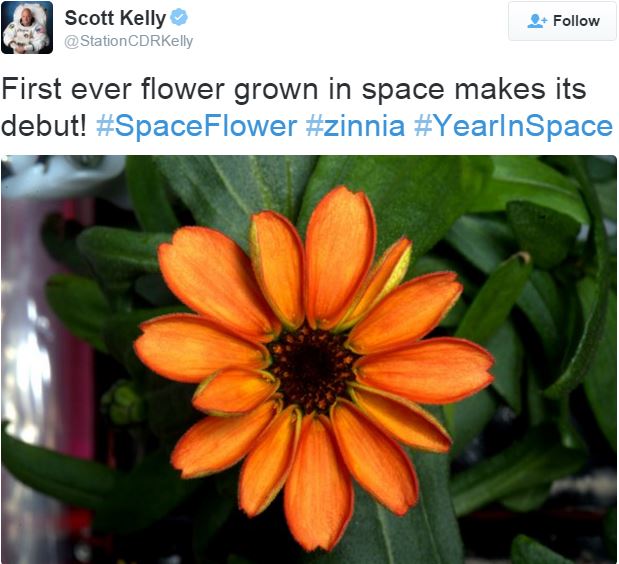 Commander Scott Kelly, the proud space gardener, shows off his prize zinnia flower in full bloom. (Image: twitter.com/StationCDRKelly)
Commander Scott Kelly, the proud space gardener, shows off his prize zinnia flower in full bloom. (Image: twitter.com/StationCDRKelly)
According to NASA, zinnias were chosen for this experiment not for their beauty, but simply to see how plants flower in a weightless environment.
Dr. Gioia Massa, NASA science team lead for Veggie, said:
“While the plants haven’t grown perfectly. I think we have gained a lot from this, and we are learning both more about plants and fluids and also how better to operate between ground and station. Regardless of final flowering outcome we will have gained a lot.”
From drought to flood conditions – problems good for learning
The Veggie plant growth facility was installed in ISS in May 2014, when a crop of Outredgrous’ red romaine lettuce was activated for growth. During its first cycle there were some problems.
Trent Smith, Veggie Project Manager, said they lost two lettuce plants due to drought stress in the first grow. So, during the second crop everybody was extra vigilant.
If a plant does not receive enough water from rainfall or irrigation, the resulting drought stress can reduce growth more than all the other environmental stresses put together.
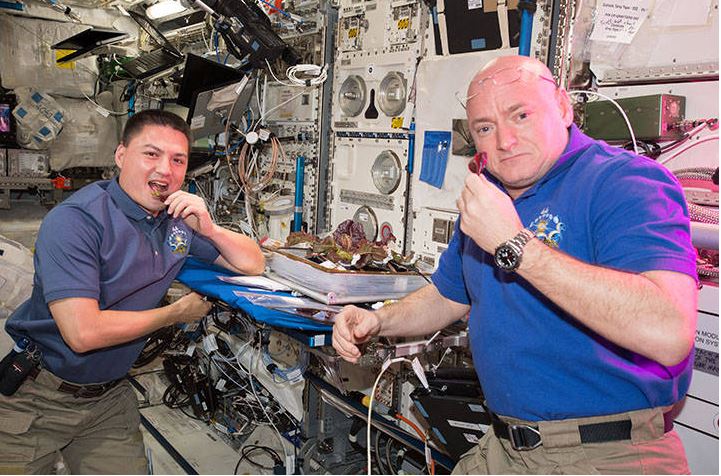 Astronauts Scott Kelly and Kjell Lindgren take a bite of space plants harvested for the VEG-01 investigation. (Image: www.nasa.gov)
Astronauts Scott Kelly and Kjell Lindgren take a bite of space plants harvested for the VEG-01 investigation. (Image: www.nasa.gov)
Commander Kelly activated the second crop in early July, and thanks to what had been learned during the first run, adjustments to watering and collecting imagery of the lettuces were made.
The plants grew according to plan, with just one plant pillow not producing. When they were harvested a month later, they were eaten by the crew members.
Zinnia flowers – precursors to tomato plants
The next crop was a batch of zinnia flowers, which scientists and Commander Kelly hoped would help them understand how plant flowers grow in a weightless environment.
Mr. Smith said:
“The zinnia plant is very different from lettuce. It is more sensitive to environmental parameters and light characteristics. It has a longer growth duration between 60 and 80 days. Thus, it is a more difficult plant to grow, and allowing it to flower, along with the longer growth duration, makes it a good precursor to a tomato plant.”
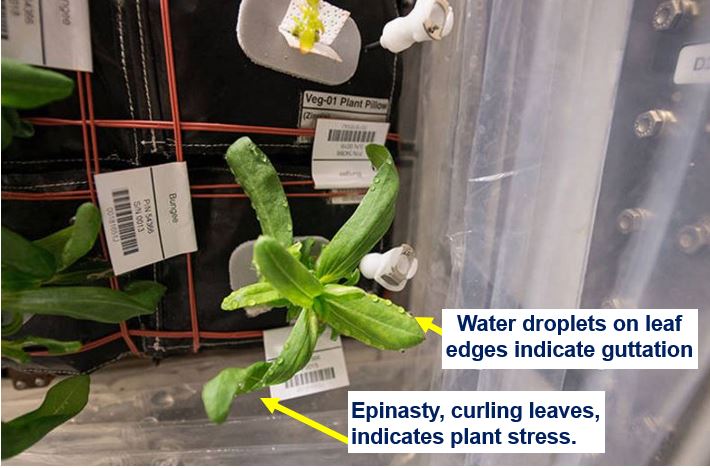 The zinnia plants started exhibiting guttation and epinasty, both signs of plant stress. (Image: www.nasa.gov)
The zinnia plants started exhibiting guttation and epinasty, both signs of plant stress. (Image: www.nasa.gov)
Within a couple of weeks into their growth period, however, NASA astronaut Dr. Kjell Lindgren noticed that water was seeping out of the wicks – white flaps that contain the seeds and protrude from the tops of the plant pillows.
Three of the plants were partially engulfed by the water. Guttation on the leaves of some of the plants was observed within ten days. Guttation is the secretion of droplets of water from the pores of plants, i.e. the plants were ‘sweating’. This can occur when humidity is very high.
The zinnia leaves also started bending down and curling drastically. The symptoms pointed to epinasty, which can occur when the roots are flooded. NASA botanists believed it was caused by inhibited air flow in the plant facility, which together with the excess water, could cause serious problems for the crop.
 In August 2015, fresh food grown in the microgravity environment of space was officially on the menu for the first time for astronauts aboard the International Space Station. (Image: www.nasa.gov)
In August 2015, fresh food grown in the microgravity environment of space was officially on the menu for the first time for astronauts aboard the International Space Station. (Image: www.nasa.gov)
Mr. Smith said:
“After observing the guttation and more significant amounts of free water we decided to see about toggling the Veggie fan from low to high. We had evidence indicating reduced air flow through the internal Veggie facility volume, and needed to toggle the fan to high to dry things out.”
They had to postpone the fix however, because an unplanned spacewalk had to be done in mid-December. By that time, tissue in the leaves of a number of plants started to die.
Pre-Christmas crisis
Mr. Smith was woken up on 22nd December at 3:45 am – there was something seriously wrong in the space garden. “When you have high humidity and wet surfaces,” he explained, “leaves start dying, and become prime real estate for mold to grow.”
By 4 am, Smith was out of bed and the whole Veggie team was on the phone. Four hours later, they had written out some new procedures and communicated them to Commander Kelly, who was in charge of the zinnias after Dr. Lindgren returned to Earth on 18th December.
Commander Kelly put on a dust mask and cut away at the affected, moldy plant tissue. He then placed what he had collected into the MELFI (Minus Eighty-Degree Laboratory Freezer for ISS) so it could be studied back on Earth at a later date.
He sanitized the plant surfaces and plant pillow surfaces with cleaning wipes, while the fans continued at high speed so that, hopefully, the Veggie chamber would dry out and the mold growth would be gone.
 Dr. Shannon Lucid aboard the Russian Mir station in 1996, looks in on the wheat crop she planted in the SVET greenhouse. (Image: larouchepub.com)
Dr. Shannon Lucid aboard the Russian Mir station in 1996, looks in on the wheat crop she planted in the SVET greenhouse. (Image: larouchepub.com)
Commander Kelly told ground staff on Christmas Eve that there were some new problems. The fans were working too well – the crop was drying out too much. He wondered whether the plants might need more water. However, he was told the next watering was scheduled for 27th December and it would be best to wait till then.
Commander Kelly said to the ground team:
“I think that would be too late. You know, I think if we’re going to Mars, and we were growing stuff, we would be responsible for deciding when the stuff needed water. Kind of like in my backyard, I look at it and say ‘Oh, maybe I should water the grass today.’ I think this is how this should be handled.”
Mr. Smith, who agreed, said “We’d been planning on figuring out how to garden autonomously and his request was just perfect. Christmas Eve 2015 was our gift!”
Kelly became the autonomous gardener
That is how Commander Kelly became the International Space Station’s autonomous gardener.
Mr. Smith said:
“This is perfect – he has the helm. We turned over care to Scott. He’s seen the lettuce, he’s got all the tools he needs, so we just provided him quick guidelines to understand the zinnias.”
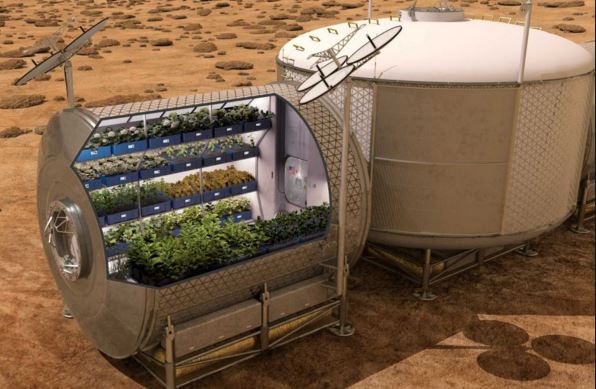 Human pioneers in Mars will have to grow their own food. Experiments on ISS will help make this possible. (Image: www.nasa.gov)
Human pioneers in Mars will have to grow their own food. Experiments on ISS will help make this possible. (Image: www.nasa.gov)
The Veggie team created what they called ‘The Zinnia Care Guide for the On-Orbit Gardener,’ So, Commander Kelly was given the basic guidelines for the plant’s care, and had to make judgments about what to do on his own.
The care guide, unlike other multi-page documents, was just one-page long, which was great for the autonomous gardener 250 miles from the Earth’s surface.
The scientists on the ground said the zinnia experience has offered them a multitude of learning opportunities. The experience drove home what science experiments are all about – finding out what does not work, and looking for ways to solve it.
For long-distance space missions, such as the one planned for Mars, scientists need to know what would happen if crops experienced mold growth, flooding, drought, or other problems, Mr. Smith explained.
They would need to know whether cutting away dead tissue and sanitizing plants work, how changing the watering schedule may affect growth, and how crew members can be given more opportunities to take over the gardening process.
Mr. Smith said:
“All these things are so rich in information, my head kind of spins to think about what to focus on. This is perfect. This is really getting us down the road for other crops.”
The Veggie team had been hoping one day to move towards autonomous gardening. When Commander Kelly suggested it they were over the Moon.
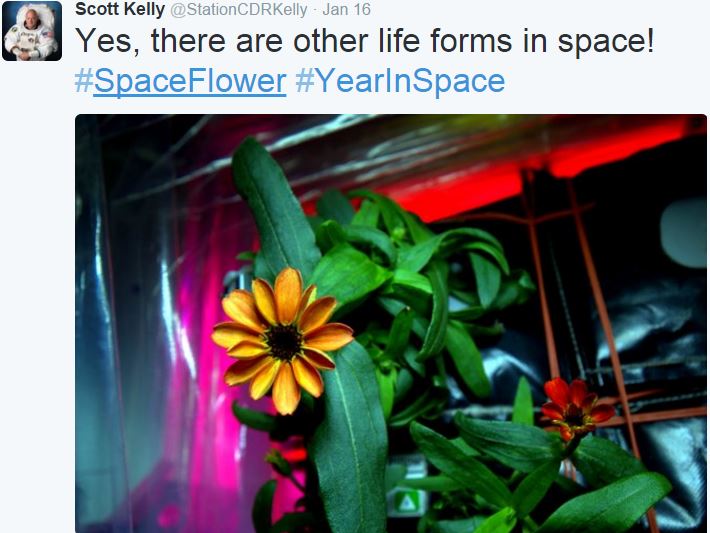 This zinnia plant is clearly thriving. (Image: twitter.com/StationCDRKelly)
This zinnia plant is clearly thriving. (Image: twitter.com/StationCDRKelly)
A festive season triumph
Shortly after Commander Kelly’s heroic Christmas season gardening efforts, two of the plants that had shown symptoms of stress died, and were clipped and placed in the freezer for further study.
However, not all hope was lost. The remaining two plants continued thriving, and even had new offshoots of buds forming.
Mr. Smith said:
“We see them growing out of their stressed states as seen by the new growth not showing leaf curling. We see that we can use our fan to adjust the conditions. We don’t see guttation or free water. So, lots of things and better understanding of our tools for the on-orbit autonomous gardener.”
Commander Kelly tweeted a picture of the plants’ progress on 8th January, and then another photo, posted on 12th January showed the first petals starting to sprout on a few buds – and then more pictures followed.
An exciting opportunity for the whole crew
The blossoming of the flowers represents an exciting opportunity for the entire crew, not just Commander Kelly. According to previous crew members, when astronauts become involved in plant experiments, it brings them closer together.
In 1996, when NASA astronaut Shannon Lucid grew wheat stalks on the Russian Mir station, the entire crew was called to inspect the new seed heads on the tips of the stalks.
In 2014, when ISS’s first batch of lettuce was harvested, several crew members took part in the event. When the second batch of lettuce was harvested in August last year, and crew members were allowed to eat the fruits of their labour, they got together and shared the produce with crew members from other countries.
Alexandra Whitmire, deputy element scientist for the Behavioral Health and Performance (BHP) element in the NASA Human Research Program (HRP), said:
“Plants can indeed enhance long duration missions in isolated, confined and extreme environments – environments that are artificial and deprived of nature.”
“While not all crew members may enjoy taking care of plants, for many, having this option is beneficial.”
While evidence pointing to the psychological benefits of growing plants in space is anecdotal, Ms. Whitmire believes efforts like Veggie will provide them with important information in preparation for a mission to Mars.
Ms. Whitmire said:
“In future missions, the importance of plants will likely increase given the crews’ limited connection to Earth. Studies from other isolated and confined environments, such as Antarctic stations, demonstrate the importance of plants in confinement, and how much more salient fresh food becomes psychologically, when there is little stimuli around.”
She added that the implications of plant life for future space missions is very significant.
Different plants planned for space station
More crops for Veggie will be making their way to ISS aboard SpaceX-8. The Veg-03 run will include one set of red romaine lettuce, and two sets of Chinese cabbage.
The Veggie team plans to send dwarf tomato seeds to ISS in 2018. What has and will be learned from growing zinnia flowers will be crucial in the process of growing tomatoes, which is also a flowering plant.
A study, which is currently underway, is looking how plant mineral composition might be affected by adjusting the lighting in the Veggie plant growth facility.
For the moment, scientists will continue monitoring the zinnia crop closely. The ground team is following Kelly’s lead care based on his observations.
NASA wrote:
“The unexpected turns experienced during this Veggie run have actually offered bountiful opportunities for new learning and better understanding of one of the critical components to future journeys to Mars.”
Mr. Smith says one has to understand, however, that a space garden is just like any other garden – there are times when things just don’t grow. “I’m an eternal optimist,” Mr. Smith said.
Video – Commander Kelly grows first flower ever in space

